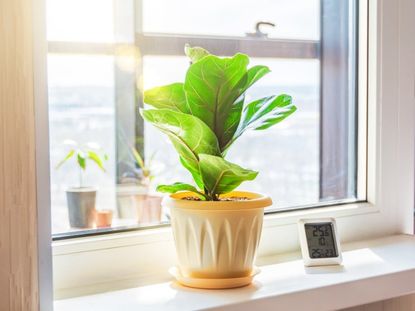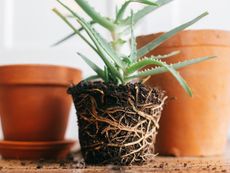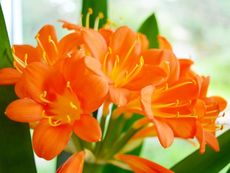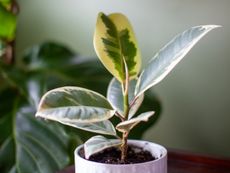Reducing Humidity With Plants: Learn About Plants That Absorb Humidity


Winter mold, mustiness, and dampness in the home are caused by excess humidity. The problem happens in warm, muggy regions too. Dehumidifiers and other solutions can have some effect, but plants are a prettier, more natural way to remove some of the clammy air and damp ambiance. Humidity-absorbing houseplants serve dual purposes as they harvest the moisture they need from the air and bring the outdoors in.
Reducing Humidity with Plants
Using plants in the home can be useful in many ways. One of the more interesting uses is their use as dehumidifiers. What plants absorb humidity? Actually, most plants harvest some moisture from the air through their leaves, but a few are extremely efficient at the process and take much of their moisture through their leaves. This is good news since high moisture levels in the home can be associated with respiratory problems and threaten the structure of your house.
You may wonder how plants can reduce humidity in the home. The answer is found in a plant's foliar uptake. This is its ability to absorb dew, fog, or other forms of vaporous moisture through the stoma in the leaves. This moisture moves into the xylem and then down the roots.
Plants that like moist soil are more likely to evolve this adaptation, but some plants in arid areas with little rainfall may also be able to process moisture in this manner. Therefore, if you pick the right plants that absorb humidity, you can reduce the excess ambient moisture in your home and prevent mold and mildew issues.
What Plants Absorb Humidity?
Even if you are going for a rainforest effect in the home, too much damp, sticky air does not produce the tropical sultry tones found in such places. In fact, you are more likely to have musty curtains and other fabrics, clammy surfaces, and weeping walls.
The peace lily is one attractive foliar plant with an interesting spathe that will help reduce moisture in the air. Classic Victorian-era plants such as English ivy, parlor palm, and Boston fern provide elegant notes to décor while removing some of that stickiness from the air. It is possible that reducing humidity with plants like these can help keep excess moisture from the air and possibly save your sagging wallpaper and musty back room.
The plants listed above all tolerate or crave moisture but a surprise plant for reducing humidity is Tillandsia, which cannot tolerate excess moisture at all. However, it absorbs most of its moisture from the air, making it great for absorbing humidity. This is because it is an epiphyte and does not live in the soil. Instead, the plant attaches to a log or rock, inserts itself into a tree crotch, or snuggles into a crevasse.
Gardening tips, videos, info and more delivered right to your inbox!
Sign up for the Gardening Know How newsletter today and receive a free download of our most popular eBook "How to Grow Delicious Tomatoes."
This little plant is also called air plant because of its epiphytic nature and ability to live in a soilless situation and still feed and water itself. The fun part about Tillandsia is the many forms, some of which have bright flowers. You can also mount Tillandsia on many different media or simply place them in a decorative bowl or directly on a shelf. They are easy to care for and may eventually produce little pups that you can divide, making even more humidity-absorbing houseplants.

Bonnie Grant is a professional landscaper with a Certification in Urban Gardening. She has been gardening and writing for 15 years. A former professional chef, she has a passion for edible landscaping.
-
 Urban Beekeeping Guide: Top Tips For Raising Bees In The City
Urban Beekeeping Guide: Top Tips For Raising Bees In The CityUrban beekeeping can be a rewarding and appreciated pastime, but first be sure it’s legal in your city and learn the ropes of beekeeping.
By Mary Ellen Ellis
-
 2024 Plant Of The Year: Why Experts Say Philodendron Is The “It” Plant Of The Year
2024 Plant Of The Year: Why Experts Say Philodendron Is The “It” Plant Of The YearWe aren’t surprised that philodendron was designated the plant of the year. Versatile, easy-care and lovely, it’s the houseplant of the year 2024!
By Bonnie L. Grant
-
 8 Easy Care Houseplants That Live A Long Time
8 Easy Care Houseplants That Live A Long TimeClick here to learn about our 8 favorite low maintenance houseplants that can, with proper care, live a long time.
By Amy Grant
-
 How Often Should You Repot Plants?
How Often Should You Repot Plants?Escaping roots and shrinking leaves may mean your plant wants a new pot, but some like staying cramped and cozy.
By Mary Ellen Ellis
-
 Orange Flowering Houseplant Varieties With Tropical Flair
Orange Flowering Houseplant Varieties With Tropical FlairClick here to learn about some cheerful orange-blooming houseplants you can try growing.
By Mary Ellen Ellis
-
 Variegated Houseplants With Lovely Leaves
Variegated Houseplants With Lovely LeavesWhat are some of the best variegated houseplants to add to your collection? Click here to find out.
By Amy Grant
-
 Lovely, Lacy Indoor Foliage Plants
Lovely, Lacy Indoor Foliage PlantsClick here to learn about some houseplants with lacy foliage to add to your collection.
By Mary Ellen Ellis
-
 Best Christmas Houseplants And Plants For Winter Holidays
Best Christmas Houseplants And Plants For Winter HolidaysClick here for an idea of the best houseplants to use for holiday décor for Christmas, Hanukkah, Kwanzaa, and New Year’s.
By Laura Miller
-
 Best Big Houseplants To Create An Indoor Oasis
Best Big Houseplants To Create An Indoor OasisIf you have the space you may want to grow some large houseplants. Here are some ideas.
By Mary Ellen Ellis
-
 Relaxing Plants To Grow Indoors For A Calmer Mind
Relaxing Plants To Grow Indoors For A Calmer MindAre there houseplants that can help you to relax? Click here to find out.
By Laura Miller